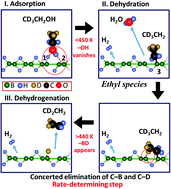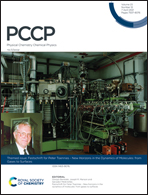Ethanol–ethylene conversion mechanism on hydrogen boride sheets probed by in situ infrared absorption spectroscopy†
Abstract
Two-dimensional hydrogen boride (HB) sheets were recently demonstrated to act as a solid acid catalyst in their hydrogen-deficient state. However, both the active sites and the mechanism of the catalytic process require further elucidation. In this study, we analyzed the conversion of ethanol adsorbed on HB sheets under vacuum during heating using in situ Fourier transform infrared (FT-IR) absorption spectroscopy with isotope labelling. Up to 450 K, the FT-IR peak associated with the OH group of the adsorbed ethanol molecule disappeared from the spectrum, which was attributed to a dehydration reaction with a hydrogen atom from the HB sheet, resulting in the formation of an ethyl species. At temperatures above 440 K, the number of BD bonds markedly increased in CD3CH2OH, compared to CH3CD2OH; the temperature dependence of the formation rate of BD bonds was similar to that of the dehydration reaction rate of ethanol on HB sheets under steady-state conditions. The rate-determining step of the dehydration of ethanol on HB was thus ascribed to the dehydrogenation of the methyl group of the ethyl species on the HB sheets, followed by the immediate desorption of ethylene. These results show that the catalytic ethanol dehydration process on HB involves the hydrogen atoms of the HB sheets. The obtained mechanistic insights are expected to promote the practical application of HB sheets as catalysts.

- This article is part of the themed collection: Festschrift for Peter Toennies - New Horizons in the Dynamics of Molecules: from Gases to Surfaces


 Please wait while we load your content...
Please wait while we load your content...